 |

0600 Hours
After an early rise, we have a light breakfast and enjoy a casual start to our day. Briefings on ship operations orient the crew to weighing anchor and line handling. This is an operation that must work perfectly.
|
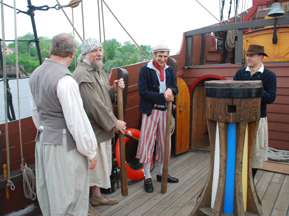
0830 Hours
Eventually, time comes to get the ship underway. The crew splits into several teams in order to weigh anchor.
|
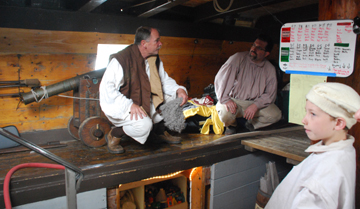
On the orlop deck, Captain Reynolds offers a general overview of the procedure and specific instructions to the below decks team.
|
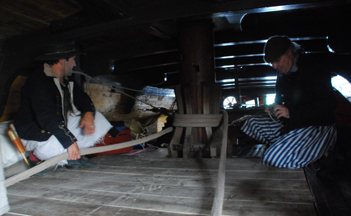
Sailors working below decks tend to the anchor rode as it enters the orlop deck through a hawsehole and passes around the lower capstan. Their job is to ensure the line does not slip and to prevent overrides, which could quickly lead to a tangle.
|
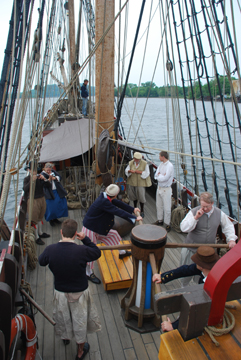
0845 Hours
Meanwhile, the weather deck team inserts their bars in the upper capstan and the fore deck team stands ready.
|
Mouse over to walk the capstan.
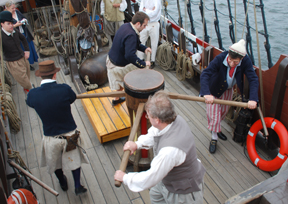 |
By walking the capstan, the crew winds the anchor rode around this massive winch, hauling up the anchor (which alone weighs about 400 lbs., plus another 400 lbs. for its chain).
With everyone working together, the anchor rode comes in quickly and smoothly.
|
Mouse over to sweat the anchor tackle.
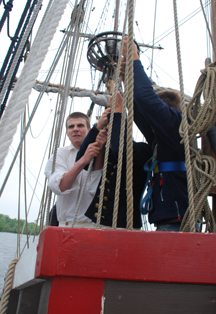 |
Once the anchor breaks the water line, the fore deck team hooks it onto a tackle and hauls it up past the hawseholes to the fore channel. Even with a block-and-tackle system, sweating this line is heavy work.
|

0900 Hours
On the fore channel, Frank Rodrigues maneuvers the anchor into position. It is soon secured and once again ready to be deployed.
With the anchor secure, we can be on our way.
|
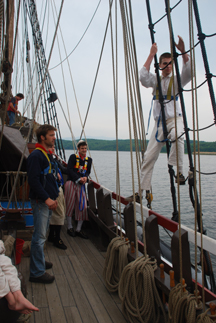
0915 Hours
Those members of our re-enactor crew who arrived last night can now take the opportunity to receive training in the rig.
|
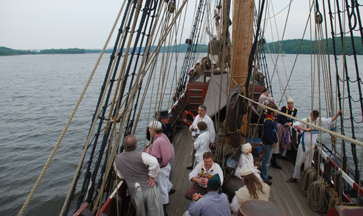
Our plan for the day is to proceed south beyond Catskill, then turn about and sail back north on the wind. However, two fronts -- first warm, then cold -- are currently pushing their way toward the region, so we expect thunderstorms and hail come the afternoon.
For the moment, however, all the coming storm can do is provide us with excellent sailing winds.
|
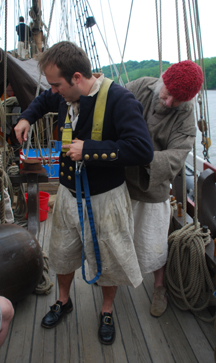
0930 Hours
Having now been trained in the use of a safety harness, several of our new crew members prepare to climb aloft and work in the rig.
|

1000 Hours
Our climbers unfurl the courses, then continue up to unfurl the top sails. At least one crew member will remain aloft on each mast to man the top sail.
|
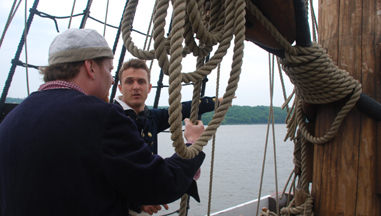
Meanwhile, Pete Condrick and Jim Gartner keep alert on the fore deck, acting as lookouts. Due to the physical limitations of the whipstaff, the crew actually steering the ship have an obstructed view of the water; lookouts act as their eyes, watching for obstacles and river traffic.
|
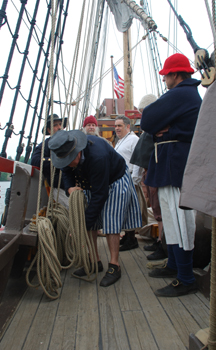
Line handling training continues as we set the sails and cut the engine. Read all the books you will, but one must get hands on to learn the workings of braces, sheets, tacks, bowlines, clews, bunts, martinettes, leech lines, etc. The learning curve with this crew is pretty quick - nothing like a motivated crew to get with the program. In short order we are bracing, setting, dousing, trimming, and handling the sails like old hands.
|
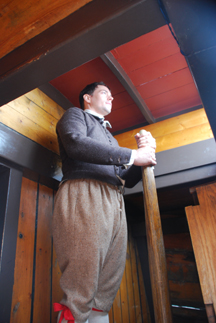
1015 Hours
Matt Brenckle mans the whipstaff. The whipstaff handles very differently depending on the current traveling conditons -- such as whether the ship is under sail or on engine power -- and always takes some getting used to.
|

1030 Hours
Randi dell'Acqua is helping us design and create new period uniforms, similar to the slops Nick is wearing here. As part of her work, she's shown Nick how to sew the seams on a miniature pair of britches made from scrap fabric.
I don't think you're going to grow into those, Nick!
|
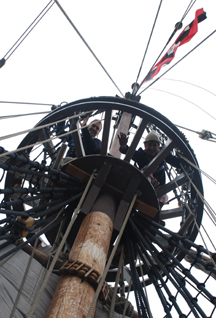
Up above, the top men prepare to set the top sails -- and enjoy the thrill of seeing the Hudson River from four stories in the air.
|
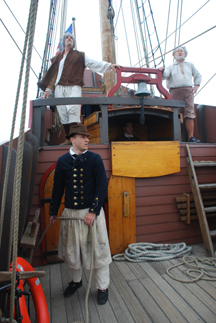 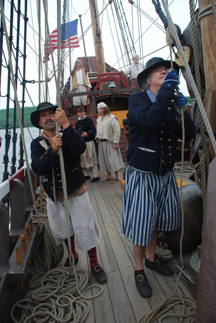
Below Catskill our mast teams prepare to set sail.
On the starboard side, Pete Condrick mans the main course sheet. Afore of him, Scott Padeni and Ron Toelke man the clew, martinette, and bunt.
|
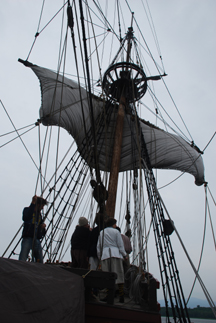
We intentionally backwind the fore course. This pushes the ship's bow away from the wind, thus turning the ship around. The narrow portions and twisting turns of the Hudson River provide ample opportunity for practicing such maneuvers.
|
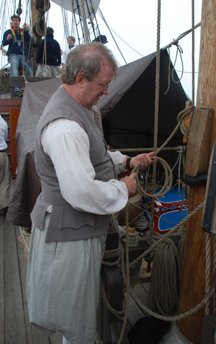
Roy Vitters tends the bunts. Each adjustment of sail requires the crew to clear the decks and ready the lines for the next evolution -- not to mention that the constant handling of lines helps cement the location and function of each line in our minds.
|
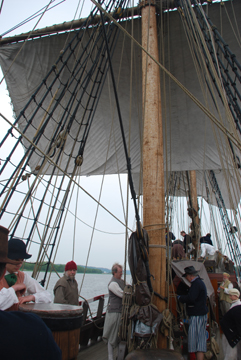
Neatly set, the courses carry the ship northward and lift our spirits. |
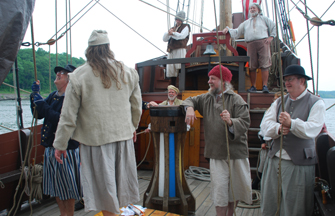
1045 Hours
The morning sail will be intensive, as we want to accomplish as much as possible before the afternoon weather brings the cold front and thunderstorms.
|
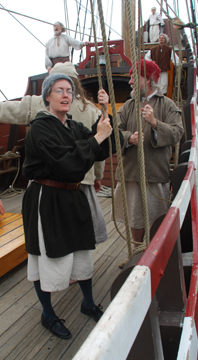 
1115 Hours
Setting and dousing the sails takes a little extra oomph as the wind rises. Teamwork counts -- as does body mass!
1200 Hours
Normally, lunch comes at noon, but gusty winds keep us at our sail handling -- everything needs to be well set to account for shifting winds and sudden gusts. Eventually, the sails are in good shape and the crew takes a break for something much tastier than hard tack. Thanks to Laurie and Reid Waller.
|

1330 Hours
A light rain doesn't dampen spirits; in fact, the cooling effect is quite pleasant after all the sweat of the morning.
|
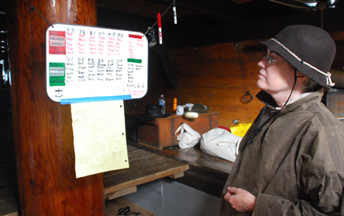
Even during a short sail, ship's discipline is important to maintain. Our watch board is key to keeping this discipline -- when not sure what to do, a quick glance at the watch board tells just what each crew member should be doing each hour of the day.
|
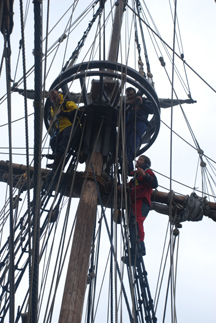
The hazardous weather warnings predict the stormier conditions to arise soon, so we prepare for the weather. The sails are furled and sailing comes to an end.
|
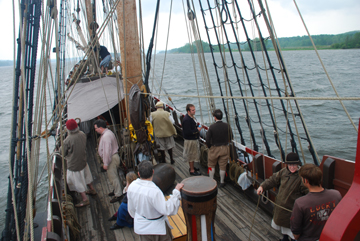
1430 Hours
The trip back to the Athens Channel and Peckham Materials provides an opportunity to debrief and review what we have learned and experienced so far today.
|
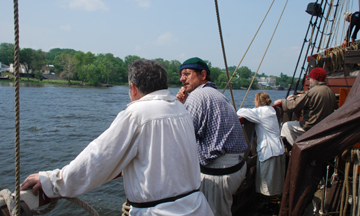
1515 Hours
We view the Village of Athens waterfront before approaching Peckham Materials.
|
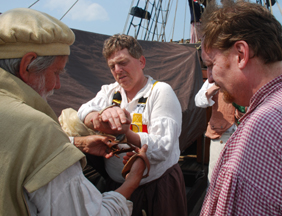
A discussion of palms and the protection of the sailmaker's hands ensues even as we approach the dock. Never a dull moment.
|
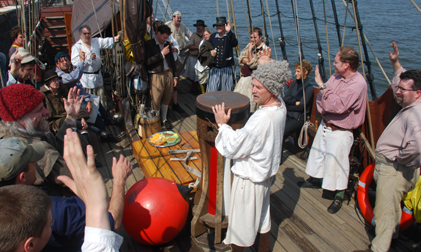
1545 Hours
The ship is secure at Peckham Materials, and mooring lines are set.
Captain Reynolds convenes the crew on deck for a review of sailing and a survey of interests for the rest of the day and weekend.
We split into several groups, based on invididual crew members' interests. These include: historic navigation, sail handling, knots and marlinspike, clothing and black powder arms.
|
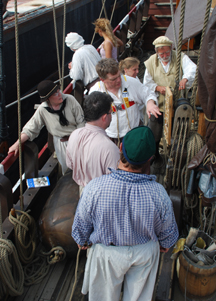 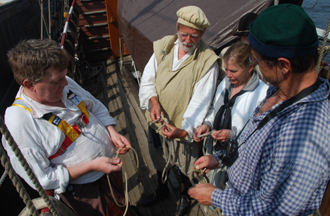
Frank Rodrigues and Henk Morel lead the group through basic knots and line handling.
|
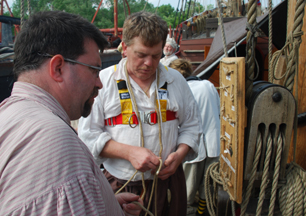 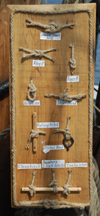
Eugene Andreassi focuses in on Frank's knot board.
|
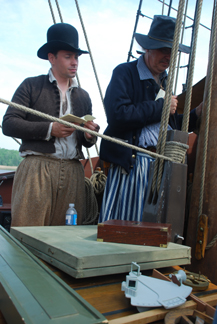 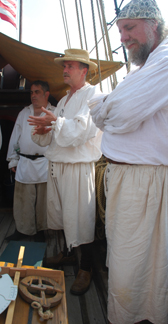
Another group meets on the quarterdeck to disucss historical navigation techniques. Steve Eftimiades left behind some of his handmade instruments for crew members to examine, and Captain Reynolds provides background on the development of navigational sciences.
|
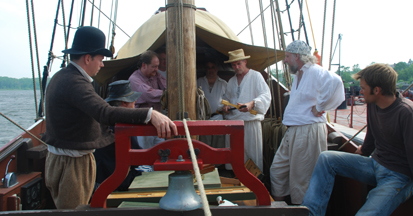
Various instruments, from kamal to quadrant to cross staff to astrolabe to nocturnal, come up for discussion.
|
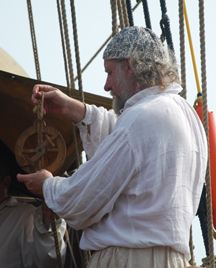
Mark Gist, from the Santa Maria, displays his handmade mariner's astrolabe. This is similar to that used by Columbus in his voyage.
|
Mouse over to put Nick to work.
|
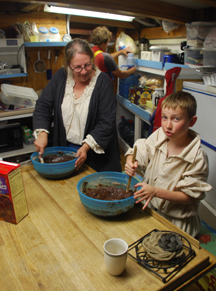
Down in the galley, our cook, re-enactor Laurie Waller, and her galley assistant Nick are allowing themselves a slight risk of historical anachronism in the name of fudge brownies.
|
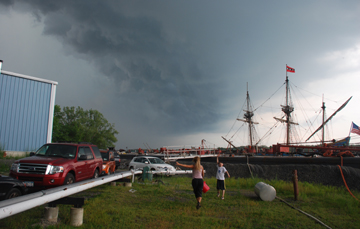
1645 Hours
Here comes the storm, which brings a quick return to the safety of the ship from crew who had to step ashore for chores.
|
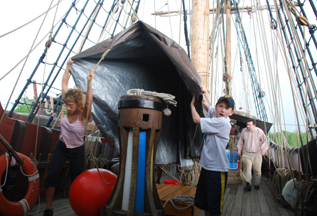
Just like sails, tarps go up quickly with practice.
|
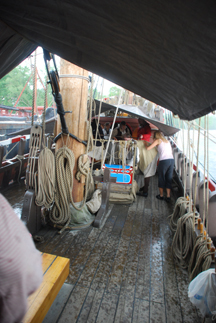
Just in time! A brief but intense downpour washes over the ship.
|
1700 Hours
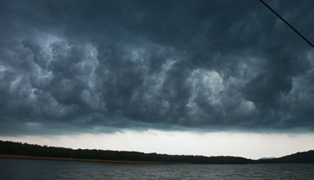 
During a break in the rain, we peer south to see these roiling thunderclouds heading our way. The left-hand photo is the southeastern view, over Athens Channel and the Middle Ground Flats; the right-hand photo is due south, over Athens itself.
|
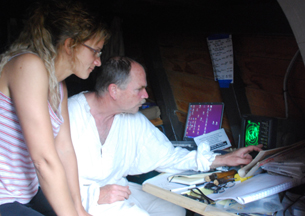 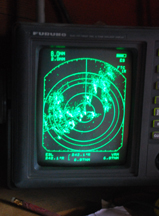
Captain Reynolds checks the radar (a device not terribly common in 1609) to see how long the storm front will hang over us. He estimates the front's speed to be roughly 20 miles an hour, so the worst of it will quickly pass, but the threat of lightning will likely persist throughout the night.
|
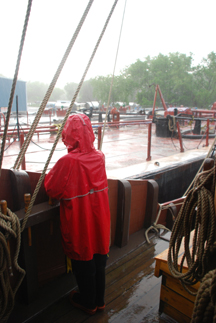
1730 Hours
As the skies open up yet again, Nick Reynolds stands a lonely vigil on the quarter deck.
|
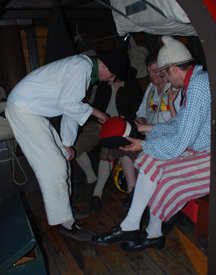
For the rest of the crew, activity has moved below decks.
In the foc's'le, Frank Rodrigues uses his laptop computer to display designs in an insider's discussion of period clothing, including styles of the period and how or where to make or procure historical garb now.
|
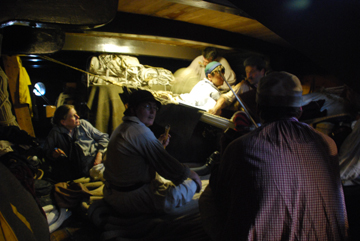
In a cozy spot under the stairs on the orlop deck, our musically inclined re-enactors have clustered together for a jam session. The notes of one tradional song after another waft through the ship well into the evening.
|
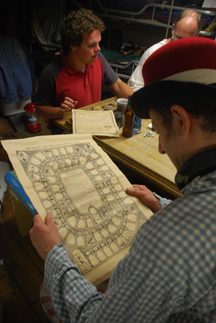
Down in the comfortable warmth of the galley, Paul Camina looks for interested parties to play "Goose," a traditional Dutch board game (which is usually played with a few wagers on the table).
|
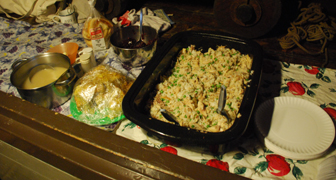
1830 Hours
Dinner is served! Tonight we're enjoying a medley of chicken, peas, and rice.
|

The crew sticks to the comfort of the orlop deck as we enjoy our meal and settle into the evening.
|
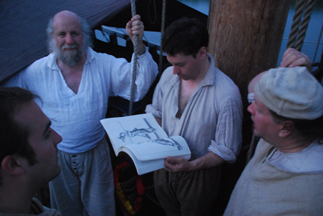
2100 Hours
As the sun sets, the rains have passed over us. Clusters of the crew chat into the evening on the weather deck, discussing period fashions and designs.
|
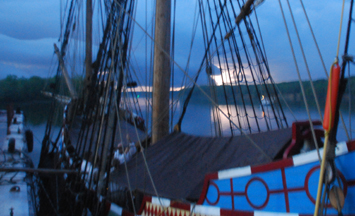
The rain may have passed, but the storm front remains nearby. We keep a close eye on the looming thunderheads to the north, which regularly flash with lightning and softly rumble with thunder.
|
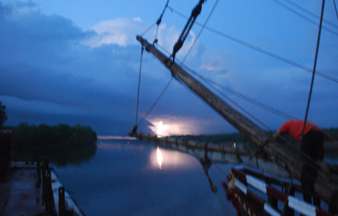
Due to this risk of lightning strikes, we've decided to remain moored at Peckam Materials through the night rather than heading back out into the channel and setting anchor.
2000 Hours
The crew members start to settle into their bunks; all but a few night owls are asleep by 2300 hours. As the night passes, we receive a few passing, scattered drops of rain, but experience no further major storm activity.
|
| |
|
|
|

